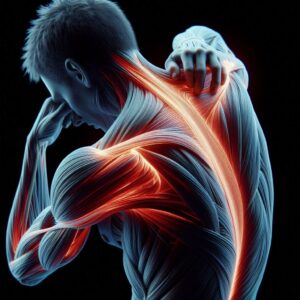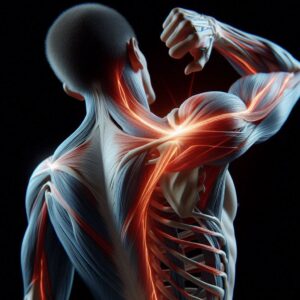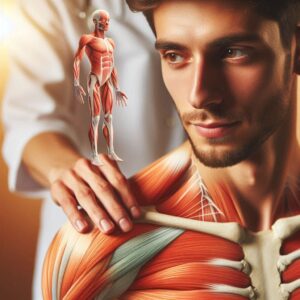Fascial Distortion Model: A Proven Approach to Treatment
The Fascial Distortion Model (FDM) is a diagnostic and treatment approach that emphasises identifying and rectifying distortions in the body’s connective tissue, called fascia. Fascia is a complex network of collagen and elastin fibres that supports muscles, organs, and structures throughout the body. Fascia distortion can lead to various symptoms, including pain, limited movement, and dysfunction in the affected area.
The FDM was created by American osteopathic physician Stephen Typaldos, D.O., in the 1990s. Dr. Typaldos noted that conventional medical approaches did not adequately address many musculoskeletal injuries and conditions, prompting him to develop a groundbreaking model for understanding and tackling these issues. The FDM categorises fascial distortions into six distinct types, each displaying unique symptoms and patterns of dysfunction.
The categories encompass Triggerband, Continuum Distortion, Cylinder Distortion, Herniated Triggerpoint, Folding Distortion, and Tectonic Fixation. The FDM distinguishes itself by focusing on the identification and treatment of specific fascial distortions through hands-on techniques rather than relying solely on imaging or other diagnostic approaches. Skilled practitioners in the FDM utilise palpation and observation techniques to identify areas of distortion within the fascia, subsequently applying focused manual therapies to address these issues effectively.
The FDM targets the underlying fascial distortions to alleviate pain, enhance function, and restore mobility in the affected body areas.
Summary
- The Fascial Distortion Model (FDM) serves as a comprehensive diagnostic and treatment framework focused on identifying and managing specific types of fascial distortions within the body.
- Fascial distortions can be identified through a comprehensive physical examination and a detailed patient history assessment—these issues frequently present as discomfort, restricted mobility, or additional symptoms.
- Treatment methods for fascial distortions can include manual therapy techniques such as manipulation, myofascial release, and exercise and movement therapies.
- The Fascial Distortion Model presents numerous benefits, including improved pain relief, increased range of motion, and faster injury recovery.
- Case studies and success stories demonstrate the effectiveness of FDM in tackling various musculoskeletal conditions and injuries.
- Integrating the Fascial Distortion Model with supplementary treatment approaches, such as physiotherapy and chiropractic care, provides a comprehensive strategy for managing patient care.
- Finding a qualified expert for Fascial Distortion Model treatment is crucial, necessitating a search for healthcare professionals with specialised training and FDM experience.
 Identifying Fascial Distortions in the Body
Identifying Fascial Distortions in the Body
Assessment Techniques
Experts skilled in FDM employ palpation and observation methods to identify specific types of fascial distortions guided by unique symptoms and patterns of dysfunction. For example, a Trigger and distortion can present as a taut, rope-like band of tissue that causes sharp, shooting pain with movement. Conversely, cylinder distortion can manifest as a swollen, sausage-shaped area of tissue that restricts movement and leads to aching or throbbing discomfort.
Assessment of Mobility and Diagnostic Imaging
In addition to palpation and observation, practitioners may employ movement assessments to identify areas of fascial distortion. By meticulously observing patients’ movements and how they perform tasks, practitioners can pinpoint areas of restricted mobility or dysfunctional movement patterns that may indicate underlying fascial distortions. Imaging studies, such as MRI or ultrasound, may be employed to confirm the presence of fascial distortions in specific cases; however, these methods are not always necessary for diagnosis.
Attention and Rehabilitation
Upon recognising fascial distortions, practitioners can develop a customised treatment plan that specifically targets these issues through focused manual therapies. These therapies may include techniques such as trigger and release, cylinder distortion reduction, or tectonic fixation reduction, all designed to precisely address each type of fascial distortion. By addressing these distortions, practitioners aim to relieve pain, improve function, and restore mobility in the affected area.
Treatment Techniques for Fascial Distortions
The treatment techniques utilised in the Fascial Distortion Model are based on precise manual therapies designed to address each type of fascial distortion specifically. These techniques encompass practical methods such as soft tissue manipulation, stretching, and mobilisation to relieve tension, reduce swelling, and restore normal function in the affected area. For example, Triggerband release techniques may involve applying pressure and stretching to the specific area to relieve tight tissue bands and reduce discomfort. Conversely, strategies for lowering cylinder distortion may employ gentle compression and mobilisation to alleviate swelling and improve mobility.
In addition to these specialised techniques, experts trained in FDM may integrate supplementary therapies such as ice or heat application, electrical stimulation, or therapeutic exercise to amplify the advantages of manual treatment and promote healing in the affected area. These complementary therapies are employed with manual techniques to address pain, inflammation, and dysfunction associated with fascial distortions. Treatment techniques in the FDM are tailored to each patient, considering their type of fascial distortion, individual symptoms, and patterns of dysfunction.
This customised approach allows professionals to effectively address the underlying pain and dysfunction issues, leading to enhanced patient results.
 Benefits of the Fascial Distortion Model
Benefits of the Fascial Distortion Model
The Fascial Distortion Model offers various benefits for those seeking relief from musculoskeletal pain and dysfunction. The FDM provides a notable benefit by focusing on the identification and treatment of specific fascial distortions that conventional medical approaches may overlook or misdiagnose. By tackling these core issues, the FDM aims to provide more effective relief from pain and dysfunction than traditional treatments, which frequently concentrate only on symptoms rather than addressing the root cause.
The FDM offers a significant benefit by emphasising practical manual therapies, which can provide immediate pain relief and improve functionality in the affected area. Many patients experience significant pain relief and improved mobility after just one or two sessions with a practitioner experienced in the FDM approach. This prompt response to treatment can be especially beneficial for those who have experienced chronic pain or limited mobility for an extended period.
FDM offers a customised treatment strategy that considers each patient’s unique symptoms and dysfunction patterns. By tailoring treatment approaches to address specific types of fascial distortions in each individual, practitioners proficient in FDM can provide more targeted and effective care that addresses the underlying causes of pain and dysfunction.
Case Studies and Success Stories
Many case studies and success stories illustrate the efficacy of the Fascial Distortion Model in relieving musculoskeletal pain and dysfunction. A case study published in the Journal of Bodywork and Movement Therapies presented a patient experiencing chronic low back pain who achieved significant relief after just two sessions of FDM treatment. The patient had pursued various conventional therapies without attaining the expected outcomes. Following FDM treatment targeting specific fascial distortions in the lower back, they reported a notable reduction in pain and improved mobility.
A case study published in the International Journal of Osteopathic Medicine examined a patient experiencing shoulder pain and restricted range of motion. A notable enhancement was observed after FDM treatment, which focused on correcting a cylinder distortion in the shoulder girdle. The patient reported significant pain relief and improved functionality after just one session of FDM treatment, underscoring the rapid effectiveness of the targeted manual therapies utilised in FDM. This compilation of case studies and success stories highlights the potential for fast relief from musculoskeletal pain and dysfunction through targeted manual therapies based on the Fascial Distortion Model.
People dealing with chronic pain or limited mobility can find significant relief and improved function after receiving FDM treatment from a qualified professional.
Integrating the Fascial Distortion Model with Other Treatment Modalities
Collaborative Assistance
Experts trained in the FDM often collaborate with other healthcare professionals, such as physiotherapists, chiropractors, and osteopaths, to develop a customised treatment plan that thoroughly addresses a patient’s condition.
Enhanced Treatment Outcomes
Combining the FDM with other evidence-based therapies, such as therapeutic exercise, chiropractic adjustments, or acupuncture, enables patients to achieve enhanced treatment outcomes and ongoing healing and recovery. This detailed approach can improve outcomes by addressing the complex needs of musculoskeletal pain and dysfunction individuals.
Tailored Treatment Solutions
Integrating FDM with supplementary modalities provides patients with an expanded range of treatment options, enabling tailored solutions to address their needs and conditions. Individuals facing intricate musculoskeletal challenges may benefit from integrating FDM treatment with physiotherapy to address strength and mobility deficits or combining it with acupuncture to reduce pain and inflammation.
 Finding a Qualified Practitioner for Fascial Distortion Model Treatment
Finding a Qualified Practitioner for Fascial Distortion Model Treatment
Individuals looking for alleviation from musculoskeletal pain and dysfunction should seek out a qualified practitioner in the Fascial Distortion Model treatment. Individuals with advanced training in FDM have the knowledge and skills to identify specific fascial distortions and apply targeted manual therapies to address these issues efficiently. When seeking a qualified practitioner for FDM treatment, patients should look for healthcare providers who have completed advanced training in FDM from reputable organisations, such as the American Fascial Distortion Model Association (AFDMA) or other recognised training institutions.
These courses provide practitioners with a comprehensive understanding of FDM principles, effective assessment techniques, and customised treatment protocols designed for each type of fascial distortion. Patients can receive referrals from their primary care physician or other healthcare professionals to locate qualified practitioners offering FDM treatment in their area. Additionally, online directories or industry associations may provide listings of practitioners who have completed advanced training in the FDM and are qualified to offer this specialised form of care.
Choosing a qualified expert for FDM treatment enables patients to receive customised manual therapies designed to address their specific fascial distortions, promoting rapid alleviation of musculoskeletal pain and dysfunction. This tailored care method can lead to more effective results for those seeking relief from chronic pain or limited mobility.
FAQs
What does the fascial distortion model (FDM) treatment entail?
The fascial distortion model (FDM) is a manual therapy approach designed to identify and relieve musculoskeletal pain and dysfunction by addressing distortions in the body’s connective tissue, called fascia.
What is the mechanism behind FDM treatment?
FDM treatment employs precise manual techniques to successfully release and realign distorted fascial tissues, relieve pain, improve mobility, and restore
Which conditions can FDM treatment assist with?
FDM treatment is commonly employed to address a range of musculoskeletal concerns, including back pain, neck pain, joint pain, sports injuries, and repetitive strain injuries.
Is FDM treatment appropriate for all individuals?
FDM treatment may not be suitable for everyone. It is essential to consult with a qualified healthcare expert to evaluate its appropriateness for your specific condition and medical history.
What potential side effects might arise from FDM treatment?
FDM treatment is generally considered safe; however, some individuals may experience temporary soreness or discomfort following a session. It is crucial to address any concerns with a qualified practitioner before undergoing FDM treatment.
What is the usual number of FDM treatment sessions required?
The number of FDM treatment sessions needed can vary depending on the individual and the details of their condition. Some individuals may observe significant improvement after just a few sessions, while others may require ongoing treatment to achieve their desired outcomes.
Brought To You By:
The Article: Fascial Distortion Model: Effective FDM Treatment appeared first on https://mcrtherapies.co.uk
The Article Fascial Distortion Model: Effective FDM Treatment appeared first on https://mcrtherapies.com
The Article Fascial Distortion Model: Effective FDM Treatment Was Found On https://limitsofstrategy.com


The Fascial Distortion Model (FDM) presents a compelling alternative to traditional medical approaches for addressing musculoskeletal injuries and dysfunctions. By focusing on the intricate network of fascia and its role in overall health, Dr. Stephen Typaldos has opened new avenues for understanding chronic pain and movement limitations. The categorization of fascial distortions into six distinct types allows practitioners to tailor their treatment strategies, enhancing the likelihood of effective outcomes.
It’s interesting to see how the Fascial Distortion Model (FDM) resonates with so many people exploring alternatives to conventional approaches in treating musculoskeletal issues. Dr. Typaldos really did a remarkable job in highlighting how the fascial network is more than just a passive structure. By addressing it, we can uncover a lot about the body’s communication system and its impact on pain and movement.
You’ve nailed it with that insight! FDM is like those fancy new phones—everyone’s been shuffling through the same old apps, and then bam! Someone comes along with a whole new operating system. The way Dr. Typaldos breaks down those six distortions feels like someone finally found the manual for our tight, cranky bodies.
You know, I really like that analogy of FDM to those fancy new phones. It’s true—just when we think we’ve got everything figured out with our routines or modalities, someone like Dr. Typaldos steps in and offers a fresh perspective that shifts how we approach our bodies. The six distortions are such a game changer because they cut through a lot of the noise and really help pinpoint what might be off.
I really appreciate the way you’ve connected FDM to that tech analogy. It’s true—most of us have been stuck in a loop with our same old patterns, and then you see something like Dr. Typaldos’ work that flips the whole script. Those six distortions really do feel like the key to a more intuitive understanding of our bodies.
You raise some interesting points about the Fascial Distortion Model and its approach to treatment. It’s clear that Dr. Typaldos has sparked a lot of discussion in the field by highlighting fascia’s role in our health. However, while the model offers a fresh lens through which to understand pain and dysfunction, it’s worth digging into some nuances.
You’ve touched on something quite important with your remark about the nuances in the Fascial Distortion Model. It’s fascinating how Dr. Typaldos has managed to shift the focus towards fascia and its impact on our overall health and well-being. But digging deeper into this model, the conversations around it really start to take shape.
You’ve hit the nail on the head! The Fascial Distortion Model definitely stirs the pot in the health community. It’s like when someone finally notices that the couch cushions are on upside down – a bit confusing but definitely worth a closer look.
It’s interesting to see how the Fascial Distortion Model (FDM) resonates with many who are dealing with chronic pain and musculoskeletal issues. FDM shifts the focus toward fascia, an often-overlooked element of our anatomy that carries a wealth of information about our physical state. Dr. Typaldos’ approach really does change the conversation around treatment.
It’s true, the Fascial Distortion Model really does shift the narrative we often have around chronic pain and musculoskeletal issues. I find it fascinating how focusing on fascia can reveal so many nuances about our body’s condition. It’s like peeling back layers to uncover hidden stories our bodies are telling us.
You’ve captured something really profound about the Fascial Distortion Model and its approach to chronic pain and musculoskeletal issues. It’s intriguing to consider how often modern medicine can focus so heavily on isolated symptoms or just the places where discomfort manifests, while the Fascia responds to tension and stress throughout the body in ways we’re only just beginning to appreciate.
It’s interesting how the Fascial Distortion Model (FDM) shifts our focus from traditional views on musculoskeletal issues to a more integrated understanding of fascia’s role in health. I’ve noticed that as more people become aware of the importance of fascia, there’s a growing interest in holistic approaches that consider the body as a connected system rather than isolated parts.
I find the Fascial Distortion Model (FDM) quite intriguing as well. It really shifts the narrative from traditional treatment methods to a deeper understanding of how our bodies are interconnected through fascia. The emphasis on this connective tissue highlights something we often overlook—how essential it is to our overall well-being.
If you’re intrigued by how our body’s fascial system impacts pain, you might find a deeper understanding of headaches equally valuable—there are so many layers to explore in how they relate to overall health.
‘Headache Types: A Complete Guide to Understanding Them’
https://brokendolls.org/headache-types-a-complete-guide-to-understanding-them/.
The Fascial Distortion Model (FDM) represents a remarkable shift in how we understand and treat our bodies’ complexities, particularly concerning the connective tissue known as fascia. It is invigorating to see such an innovative approach come to the forefront, offering hope and effective solutions to those who have struggled with persistent pain and musculoskeletal issues. Dr. Stephen Typaldos’s insights into the inadequacies of traditional medical practices catalyzed this groundbreaking model that has now transformed lives.
You’ve hit the nail on the head with your observations about the Fascial Distortion Model (FDM). It’s like finding out that those quirky little knots in our bodies aren’t just there to mess with our plans but actually have a backstory and a purpose. I mean, who would have thought that fascia—a structure that’s often treated like the wallflower of the connective tissue party—could be the star of the show? Dr. Typaldos really knocked it out of the park by shifting our perspective on muscular pain and discomfort.
You’ve captured a fascinating aspect of FDM beautifully. It’s interesting to think about those “quirky little knots” in our bodies as having their own stories waiting to be told. Dr. Typaldos’s work really challenges the way we view pain, making us rethink the traditional narrative that often oversimplifies discomfort as just a nuisance.
You’ve captured the essence of the Fascial Distortion Model beautifully. It’s interesting how our understanding of the body evolves, revealing layers of complexity that we often overlook. The idea that those quirky little knots in our bodies have a story and purpose brings new meaning to our experiences with pain and discomfort. Instead of just viewing these feelings as annoyances or signs of something gone wrong, we’re encouraged to see them as signals from our bodies, inviting us to explore and understand deeper issues.
It’s interesting to see how the Fascial Distortion Model (FDM) has emerged as a response to the limitations of traditional medical frameworks. The focus on fascia, which is often overlooked in standard treatment protocols, really highlights a more holistic approach to the body. It’s fascinating how the interconnectedness of our anatomy plays such a significant role in how we experience pain and movement.
I’ve always found the Fascial Distortion Model fascinating, especially since so many people overlook fascia’s role in overall health. I’ve had my own shoulder issues for years, and it took a while to realize that traditional treatments weren’t getting to the root of the problem. Discovering FDM was a game changer for me. The idea that specific fascial distortions cause such varied pain patterns really resonated with my experience.
It’s interesting to hear how your journey with shoulder issues led you to the Fascial Distortion Model. You’re not alone in feeling overlooked by traditional treatments; many people have similar experiences. The way fascia influences our overall health really is something that often gets lost in conversations about pain management and recovery.
It’s refreshing to hear your take on shoulder issues and the whole realm of treatment options. I completely agree that many people share similar experiences, feeling a little lost in a sea of traditional treatments that don’t quite hit the mark. My own journey was a long one, filled with frustration over those feelings of being overlooked.
It’s fascinating to dive into the Fascial Distortion Model—who knew there was a whole universe of connective tissue drama going on beneath our skin? I mean, just when you think you’ve got a handle on your knees creaking like an old door, you discover it might actually be a case of “Triggerband” distress rather than just a sign that you’re getting old!
It’s interesting to hear your thoughts on the Fascial Distortion Model. The idea that there’s a complex web of connective tissue influencing our bodies has a way of reshaping how we think about pain and movement. Many of us tend to chalk up those creaks and pops in our knees to aging, but diving into something like Triggerband distress opens up a whole new perspective.
It really is interesting to see how our understanding of the body has evolved, especially with models like the Fascial Distortion Model shedding light on issues we might’ve just attributed to aging. The concept of “Triggerband” distress is a game changer—it makes you rethink how interconnected everything really is.
Isn’t it intriguing? The concept of the Fascial Distortion Model really shines a light on how interconnected our bodies are. The idea that something like a “Triggerband” could be the culprit behind those creaky knees is both enlightening and a bit humbling, isn’t it? It makes me think about how we often attribute signs of wear and tear to age, like creaking doors that need some oil, when in reality, there’s so much more happening under the surface.
The Fascial Distortion Model (FDM) presents a fascinating perspective on musculoskeletal issues that often go unaddressed by conventional medicine. I’ve personally encountered situations where traditional treatments failed to yield significant improvements, leading me to explore alternative modalities. The insight that fascia plays such a central role in our overall function is quite illuminating—I remember a physical therapist explaining how fascial restrictions could manifest not just as localized pain but also as systemic dysfunction.
I completely resonate with your experience. The FDM really does open up a different dialogue about how we perceive and treat pain. It’s interesting to think about how often issues like fascia restrictions go unnoticed in traditional medical models, despite their profound impact on our overall well-being.
It’s great to hear about your journey with the Fascial Distortion Model, and I can relate to the experience of feeling let down by traditional medical approaches. Many people find themselves in that same position where the conventional route just doesn’t quite solve their issues. It sounds like you’re on a thoughtful quest to find what really works for you, which is crucial in our health journeys.
Reading about the Fascial Distortion Model (FDM) rekindles my interest in the intricate relationship between fascia and overall health. It’s fascinating how something as seemingly simple as connective tissue can profoundly influence our physical well-being. I remember my first exposure to the concept of fascia during a workshop on bodywork therapy, where the instructor emphasized the interconnectedness of all body systems. It became clear that addressing only the symptoms of pain or dysfunction, without considering the underlying fascial distortions, could lead to recurring issues.
It’s interesting to hear about your experience with the Fascial Distortion Model and how it sparked your curiosity about fascia and its role in health. Many people are surprised to learn just how pivotal fascia can be, as it’s often overlooked in discussions about the body.
Your experience at the bodywork therapy workshop really highlights a crucial point about fascia and its role in our approach to health. It’s intriguing how this connective tissue, often overlooked or misunderstood, serves as a central player in our physical experiences. The idea that merely treating the symptoms of pain can lead to a cycle of recurrence truly resonates with many people who have struggled with chronic issues.
The Fascial Distortion Model (FDM) presents such a fascinating perspective on the relationship between our body’s connective tissues and our overall health. It’s interesting to consider how the intricate web of fascia plays a critical role in both our physical well-being and our experience of pain and movement. I recently learned that families with a history of musculoskeletal issues, like chronic back pain or excessive tightness in muscles, often have structural disparities that could stem from fascial distortions. This brings to light the importance of addressing these underlying issues rather than just treating the symptoms, as is commonly done in conventional medicine.
You bring up such an interesting point about the Fascial Distortion Model (FDM) and the intricate role of fascia in our health. It’s quite mind-blowing to think about how these connective tissues have such a profound impact on our overall well-being, often in ways we don’t fully understand. I’ve been reading about how the fascial network is not just a passive structure but an active player in movement and pain processing.
I’ve recently started delving into the Fascial Distortion Model (FDM), and it’s been quite a journey. It’s fascinating to see how Dr. Stephen Typaldos recognized a gap in conventional medicine and sought to create a more nuanced approach to understanding musculoskeletal issues. I’ve often found that standard modalities, while effective at times, can sometimes miss the mark, especially when pain or dysfunction seems to linger without a clear diagnosis.
Delving into the Fascial Distortion Model can truly open up a new perspective on pain and dysfunction, right? Dr. Stephen Typaldos had a unique insight when he noticed that traditional approaches often fell short in addressing complex musculoskeletal issues. His exploration of the body’s fascial system is a testament to how innovative thinking can lead to deeper understanding and healing.